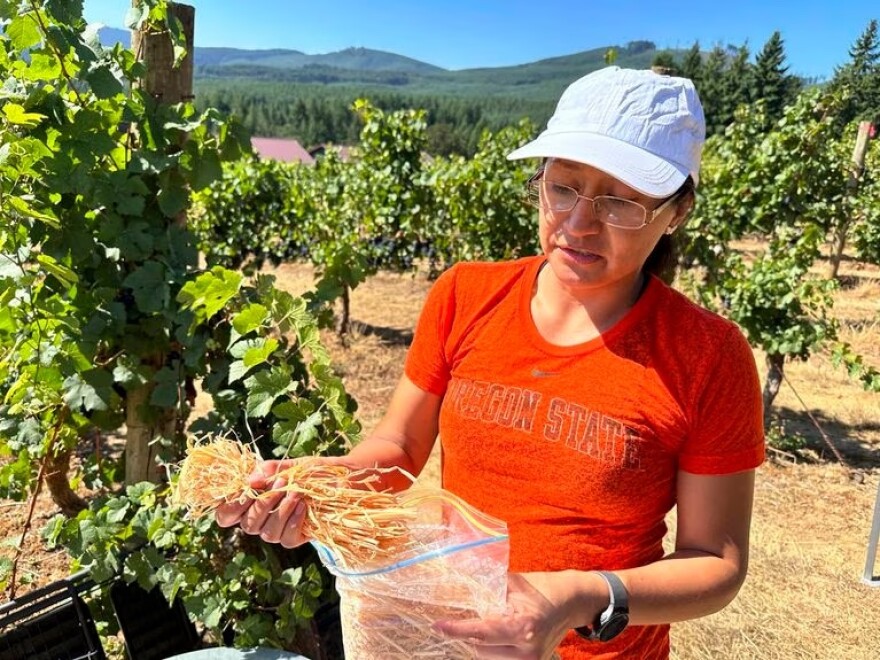Sample a good wine and you might get notes of oak or red fruit. But sip on wine made from grapes that were penetrated by smoke, and it could taste like someone dumped the contents of an ashtray into your glass.
Wine experts from three West Coast universities are working together to meet the threat, including developing spray coatings to protect grapes, pinpointing the elusive compounds that create that nasty ashy taste, and deploying smoke sensors to vineyards to better understand smoke behavior.
The U.S. government is funding their research with millions of dollars. Wineries are also taking steps to protect their product and brand.
The risk to America's premier wine-making regions — where wildfires caused billions of dollars in losses in 2020 — is growing, with climate change deepening drought and overgrown forests becoming tinderboxes. According to the , grapes are the highest-value crop in the United States, with 1 million acres (405,000 hectares) of grape-bearing land, 96% of it on the West Coast.
Winemakers around the world are already , including by moving their vineyards to cooler zones and planting varieties that do better in drought and heat. Wildfires pose an additional and more immediate risk being tackled by scientists from Oregon State University, Washington State University and the University of California, Davis.
"What's at stake is the ability to continue to make wine in areas where smoke exposures might be more common,” said Tom Collins, a wine scientist at Washington State University.

Researcher Cole Cerrato recently stood in Oregon State University’s vineyard, nestled below forested hills near the village of Alpine, as he turned on a fan to push smoke from a Weber grill through a dryer vent hose. The smoke emerged onto a row of grapes enclosed in a quasi greenhouse made of taped-together plastic sheets.
Previously, grapes exposed to smoke in the MacGyvered setup were made into wine by Elizabeth Tomasino, an associate professor leading Oregon State's efforts, and her researchers.

They found sulfur-containing compounds, thiophenols, in the smoke-impacted wine and determined they contributed to the ashy flavor, along with “volatile phenols,” which Australian researchers identified as factors more than a decade ago. Bush fires have long impacted Australia’s wine industry. Up in Washington state, Collins confirmed that the sulfur compounds were found in the wine that had been exposed to smoke in the Oregon vineyard but weren’t in samples that had no smoke exposure.
The scientists want to find out how thiophenols, which aren't detectable in wildfire smoke, appear in smoke-impacted wine, and learn how to eliminate them.
“There’s still a lot of very interesting chemistry and very interesting research, to start looking more into these new compounds,” Cerrato said. "We just don’t have the answers yet.”
Wine made with tainted grapes can be so awful that it can't be marketed. If it does go on shelves, a winemaker's reputation could be ruined — a risk that few are willing to take.
When record wildfires in 2020 blanketed the West Coast in brown smoke, some California wineries refused to accept grapes unless they had been tested. But most growers couldn't find places to analyze their grapes because the laboratories were overwhelmed.
The damage to the industry in California alone was $3.7 billion, according to an analysis that Jon Moramarco of the consulting firm bw166 conducted for industry groups. The losses stemmed mostly from wineries having to forego future wine sales.

“But really what drove it was, you know, a lot of the impact was in Napa (Valley), an area of some of the highest priced grapes, highest priced wines in the U.S.,” Moramarco said, adding that if a ton of cabernet sauvignon grapes is ruined, “you lose probably 720 bottles of wine. If it is worth $100 a bottle, it adds up very quickly.”
Between 165,000 to 325,000 tons of California wine grapes were left to wither on the vine in 2020 due to actual or perceived wildfire smoke exposure, said Natalie Collins, president of the California Association of Winegrape Growers.
She said she hasn't heard of any growers quitting the business due to wildfire impacts, but that: “Many of our members are having an extremely difficult time securing insurance due to the fire risk in their region, and if they are able to secure insurance, the rate is astronomically high.”
Some winemakers are trying techniques to reduce smoke impact, such as passing the wine through a membrane or treating it with carbon, but that can also rob a wine of its appealing nuances. Blending impacted grapes with other grapes is another option. Limiting skin contact by making rosé wine instead of red can lower the concentration of smoke flavor compounds.
Collins, over at Washington State University, has been experimenting with spraying fine-powdered kaolin or bentonite, which are clays, mixed with water onto wine grapes so it absorbs materials that are in smoke. The substance would then be washed off before harvest. Oregon State University is developing a spray-on coating.
Meanwhile, dozens of smoke sensors have been installed in vineyards in the three states, financed in part by a $7.65 million USDA grant.
“The instruments will be used to measure for smoke marker compounds,” said Anita Oberholster, leader of UC Davis' efforts. She said such measurements are essential to develop mitigation strategies and determine smoke exposure risk.

Greg Jones, who runs his family's Abacela winery in southern Oregon's Umpqua Valley and is a director of the , applauds the scientists' efforts.
"This research has really gone a long way to help us try to find: are there ways in which we can take fruit from the vineyard and quickly find out if it has the potential compounds that would lead to smoke-impacted wine,” Jones said.
Collins predicts success.
“I think it’s increasingly clear that we’re not likely to find a magic bullet,” he said. “But we will find a set of strategies.”
Copyright 2023 The Associated Press


